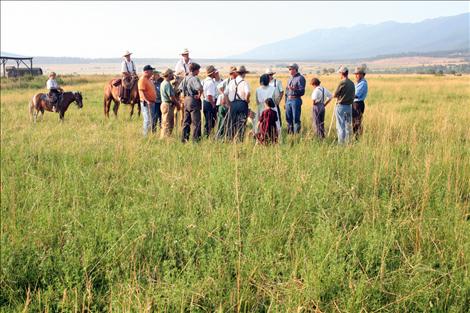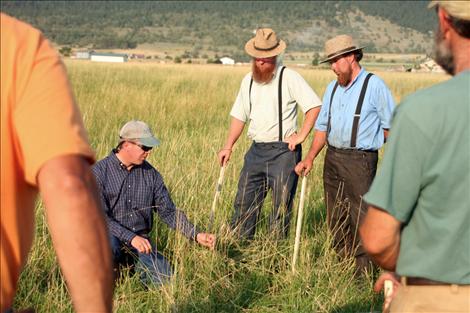Livestock change palate to help farmers
Hey savvy news reader! Thanks for choosing local.
You are now reading
1 of 3 free articles.
ST. IGNATIUS – Farmers look to nature to deal with the rising costs of operation by letting the farm animals do more of the work.
“The animals will eat and develop a taste for nutrient dense weeds along with the grass. This method takes less fertilizer. The cows will trample natural fertilizer into the ground. The system drives itself by improving the soil,” said District Conservationist Ben Montgomery, for the Natural Resource Conservation Service located in Ronan.
“It’s about getting back to nature.”
About a dozen farmers gathered last week in Vern Schlabach’s field on Ashley Lake Road to talk about rotational grazing during the fourth Pasture Walk of the season lead by Montgomery and Pasture Management Specialist Justin Morris for the Natural Resources Conservation Service.
“This method is similar to how our native herds graze,” Montgomery said.
The trick to getting animals to do the work involves allowing them to graze in smaller sections in a rotational pattern instead of letting them roam the entire field.
“If you plan your grazing with temporary fencing a lot of labor can be reduced.”
But it does take brain work to use this method.
“I don’t want to discourage people from this because a little math is involved,” Morris said.
The math includes taking the total number of acres used and dividing them into sections. The animals graze in one section at a time, and the plants appreciate the break.
“Moving the animals will allow the live plants to take a rest,” Morris said. “It’s about rest and recovery between grazing. The rest is the important part.”
“The plants need to rest to build roots to put on leaf bio- mass,” Montgomery said.
The group measured the growth of the grass in Schlabach’s field where he implemented the rotational method for the first time this year.
“I’m experimenting and learning, but considering how depleted this field was before we started, it’s doing really well. I hope to get everything out of it I can naturally; the way it’s supposed to be done.
“I think with this method we are helping grass and animals create a symbiotic relationship.”
Farmer Jerry Laskody went on the walk to talk about what has worked for him.
“I started using rotational grazing because I wanted to utilize the resource and protect it. Natural methods are better. Herbicides are expensive and time consuming. If I don’t have to spray, I won’t. Rotational grazing helps with that.”
David Sturman moves his sheep on a regular basis.
“Before we started this, the place got so bad with thistles that I had to mow them. The sheep eat the weeds now. They seem to like them. And the thistle problem is a lot less. This method is too good not to do.”
The animals require an adjustment period.
“We are all used to living in the country,” Morris said to the group of farmers. “It’s like if we go to New York City and we walk around a couple thousand people, we might get uncomfortable. We have personal space. The animals are like that. They are not used to being closer together and they’ll need to adjust.
“Adjusting to this method is like throwing a frog in hot water. It works better if you slowly turn up the heat until he gets accustomed to it.”
For information on the next Pasture Walk, contact Ben Montgomery at (406) 676-2841 ex. 111. Special guest Greg Judy from Missouri will be at the Sept. 19 Pasture Walk to explain how he perfected rotational grazing.
“He is sought after worldwide,” Montgomery said. “And he’ll be here to share what he’s learned. This method really saved his ranch.”

















